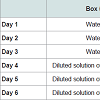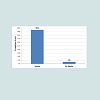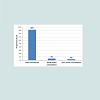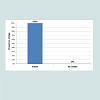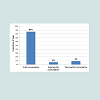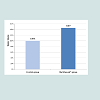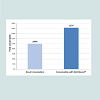Journal of Veterinary Science & Medicine
Download PDF
Research Article
*Address for Correspondence: Gwendoline Chaix, Medical Department, Virbac, 13ème Rue, Carros,France, E-mail: gwendoline.chaix@virbac.com
Citation: Chaix G, Fournel S, Crastes N, Lloret F, Monginoux P, et al. Palatability and Impact on Food and Water Intake of Nutribound®, a New Liquid Nutritional Supplement for Dogs and Cats. J Veter Sci Med. 2015;3(1): 6.
Copyright © Chaix et al. This is an open access article distributed under the Creative Commons Attribution License, which permits unrestricted use, distribution, and reproduction in any medium, provided the original work is properly cited.
Journal of Veterinary Science & Medicine | ISSN: 2325-4645 | Volume: 2, Issue: 2
Submission: 21 February 2015 | Accepted: 09 March 2015 | Published: 13 March 2015
Reviewed & Approved by: Dr. Efterpi Christaki, Professor of Nutrition, Faculty of Veterinary Medicine, Aristotle University of Thessaloniki, Greece
Impact on food intake
The results of the palatability trial performed in dogs are described in (Figure 3 andFigure 4). Prehension was noted in all dogs (35/35) (Figure 3). All dogs consumed the product, at least partially. Among the 35 dogs that accepted Nutribound®, 30 consumed it totally (Figure 4).
Impact on water intake
Impact on food intake
Palatability and Impact on Food and Water Intake of Nutribound®, a New Liquid Nutritional Supplement for Dogs and Cats
Gwendoline Chaix 1*, Sandrine Fournel2, Nolwenn Crastes2, Fanny Lloret3, Patricia Monginoux3, David McGahie1 and Natalia Bernachon1
- 1Medical Department Virbac, Carros, France
- 2R&D Virbac, Carros, France
- 3UPL Virbac, Carros, France
*Address for Correspondence: Gwendoline Chaix, Medical Department, Virbac, 13ème Rue, Carros,France, E-mail: gwendoline.chaix@virbac.com
Citation: Chaix G, Fournel S, Crastes N, Lloret F, Monginoux P, et al. Palatability and Impact on Food and Water Intake of Nutribound®, a New Liquid Nutritional Supplement for Dogs and Cats. J Veter Sci Med. 2015;3(1): 6.
Copyright © Chaix et al. This is an open access article distributed under the Creative Commons Attribution License, which permits unrestricted use, distribution, and reproduction in any medium, provided the original work is properly cited.
Journal of Veterinary Science & Medicine | ISSN: 2325-4645 | Volume: 2, Issue: 2
Submission: 21 February 2015 | Accepted: 09 March 2015 | Published: 13 March 2015
Reviewed & Approved by: Dr. Efterpi Christaki, Professor of Nutrition, Faculty of Veterinary Medicine, Aristotle University of Thessaloniki, Greece
Introduction
Nutritional support is vital to the recovery process for critically-ill patients, due to the frequent decrease of voluntary food intake, putting these patients at a major risk for malnutrition, which can result in a catabolic state [1,2]. As such, nausea, pain, some administered drugs and anxiety over hospitalisation can reduce appetite [3]. However many patients in the recovery phase do not receive enteral nutritional support specifically adapted for their critical state. In fact, solid nutrition cannot be given to some patients because of recurrent vomiting or asthenia, or the food is simply not accepted by the anorectic patient [4]. There is great interest in providing small volumes of liquid nutrition that are highly digestible and palatable for critical patients, because this could potentially increase the willingness to eat in sick animals and facilitate the first intake of food. Unfortunately liquid supplements containing useful nutrients are not always practically available or are not sufficiently palatable. One of the challenges of early, spontaneous re-feeding is to awaken interest in food in the patient in order to decrease the probability of nutritional failure. Voluntary uptake from the animal facilitates compliance whereas forced and repetitive administrations may induce aggressive responses and even nutritional aversion, especially in cats [5].Voluntary uptake is considered beneficial in veterinary medicine [6]. Thus, palatability is considered to be an essential criterion for a nutritional supplement designed for the re-feeding of cats and dogs. In companion animals, palatability refers to the voluntary ingestion of a food or a medicine. While palatability depends on the taste of the product, it is also influenced by the smell, texture, the aspect or the nutritional content (especially animal proteins) of the product [7,8].Early re-feeding in weakened animals is essential for several reasons. First, it prevents damage to the cells lining the gastrointestinal tract and avoids bacterial translocation or gut-derived sepsis. In particular, it is crucial after surgery in order to help the animal recuperate more efficiently and effectively, by ensuring optimal functioning of the immune system. Secondly, early re-feedingdelivers fluids and provides essential recovery nutrients [9,10]. The supplement of necessary nutrients enterally in the very early postoperative period is recommended to avoid intestinal villi atrophy, which can severely impair the absorption of nutrients into the blood.A study in neonatal piglets has shown that total parenteral nutrition leads to mucosal atrophy in the jejunum within 24 hours [11] nutrition in mice receiving total parenteral nutrition prevented villi atrophy compared to mice that received total parenteral nutrition without enteral nutrition. The intestinal villi atrophy observed in the group receiving total parenteral nutrition was likely due to the lack of enteral feeding and not to the total parenteral nutrition solution itself since both groups of mice received parenteral nutrition [12]. These findings stress the importance of early enteral re-feeding.
Nutribound® is a new liquid supplement for dogs and cats that need early nutritional support in various situations. This product provides water and necessary nutrients, including arginine, glutamine, taurine, essential fatty acids, prebiotics and vitamins. The main objective of this study was to assess the palatability of Nutribound® in dogs and cats. A second objective was to evaluate the impact of Nutribound® on food and water intake in cats.
Materials and Methods
The study was divided in four sub-studies to address the aforementioned objectives. Each sub-study was conducted in an independent research centre highly experienced in the palatability trial performance, to ensure the reliability and reproducibility of the observations. Each sub-study was carried out in accordance with the relevant European regulations and Virbac’s chart of ethics.Animal selection
Each sub-study included healthy adult animals, both males and females, living in an enriched environment for their well-being.
One trial was conducted using 35 dogs. For the other three trials, only cats were included, with 39 cats for the palatability trial, 37 cats for the trial on the impact on water intake and 38 cats for the trial on the impact on food intake.
Product
The tested products were Nutribound® for dogs and Nutribound® for cats, two feed supplements with the respective following compositions:
- Nutribound® for dogs: meat and animal derivatives (4.74%), derivatives of vegetable origin, oils and fats (1.29%), minerals (0.69%), chicory inulin (0.3%), oligofructose (0.113%);
- Nutribound® for cats: meat and animal derivatives (4.07%), derivatives of vegetable origin, oils and fats (1.50%), minerals (0.62%),chicory inulin (0.3%), oligofructose (0.113%).
The two formulas provide several vitamins and micro-nutrients (vitamins A, D3, E, B1, B2 and B6, choline, biotine). The safety of this product has been assessed previously [13].
Palatability trials
The objective of the first two trials was to evaluate the overall palatability of Nutribound® for dogs (group of 35 dogs) and Nutribound® for cats (group of 39 cats). The duration of each test was 10 minutes per animal. Two criteria were used to assess palatability: prehension and consumption. Prehension was defined as the act of taking spontaneously the product into the mouth, independently of whether it was then consumed or not. Consumption was defined as the act of swallowing the product. Total consumption was defined as consumption of more than 95% of the product. Partial consumption was classified in two categories: poor partial consumption, defined as less than 50% of the product consumed, and good partial consumption, defined as more than 50% and less than 95% of product consumed. Each animal received the daily recommended posology: 6 mL per kilogram of body weight for cats, and 5 mL per kilogram of body weight for dogs. Animals were observed, and possible adverse effects were noted.
Impact on water intake
The objective of this trial was to evaluate the effect of Nutribound® on water intake in cats. The 37 cats included in this trial were housed in four different boxes, numbered from 5 to 8. In effect, eight to ten cats were housed in each box. All of the evaluations were performed per group. Every morning, either 525 mL of tap water or 525 mL of a diluted Nutribound® solution were distributed in each box, from 7:30 AM to 11:20 AM, according to Table 1. After 11:20 AM, all animals received drinking water ad libitum for the rest of the day. Animals housed in boxes 5 and 6 received pure water during the first three days of the trial whereas the other two groups of cats received a diluted Nutribound® solution. Then, a crossover was performed such that boxes 7 and 8 received pure water and boxes 5 and 6 received the Nutribound® solution during the other three days. The diluted solution of Nutribound® was obtained by adding 25 mL of Nutribound® to 500 mL of tap water, leading to a 4.7% dilution rate.Water consumption per group was assessed for a period of 3 hours and 50 minutes.
The objective of this trial was to evaluate the impact of the product on usual diet consumption. The 38 cats included in this trial were housed in individual boxes. Nutribound® was administered with two daily meals, one in the morning and one in the afternoon. The food was premium or super premium kibbles. The quantity of food distributed to each cat was calculated based on their last individual consumptions as measured during previous tests. For each meal, 2.5 mL per kilogram of body weight of the product was poured on the food. The total daily consumption by each animal was recorded. Then the mean daily consumption of food accompanied by Nutribound® was calculated and compared to the mean daily reference consumption.
Statistical analyses
Statistical analyses were performed using the software SAS 9.1.3. For the trial “Impact on water intake”, the water consumption between the Nutribound® group and the water alone group during the 3 days of follow-up was compared using an ANOVA on ranks (factors: group, day, and interaction) at the 5% significance threshold. For the trial “Impact on food intake”, the mean individual consumption of the food (with Nutribound® poured on it) was compared to the mean individual reference consumption by a Wilcoxon signed rank test for each meal at the 5% significance threshold.
Results
No side effects were reported during the study and all animals remained healthy.Palatability trials
The results of the palatability trial performed in cats are described in (Figure 1 and Figure 2). Prehension was noted in 37 cats out of 39 (Figure 1). All cats in which prehension was recorded consumed the product, at least partially. Among the 37 cats that accepted Nutribound® 34 consumed it totally (Figure 2).
The impact of Nutribound® on water intake is shown in Figure 5. The mean consumptions per group during a period of 3 hours and 50 minutes were 285 grams and 195 grams for the diluted solution of Nutribound® and water alone, respectively. This increase (46%) in mean water consumption when Nutribound® was diluted in the drinking water compared to the mean consumption of water alone was statistically significant (p=0.001).
The mean daily consumption of food when Nutribound® was poured on it was 69.58 grams whereas the mean daily consumption of food alone was 42.8 grams. The daily consumption of food was statistically significantly increased when Nutribound® was poured on it (p< 0.001), as shown in Figure 6, compared to the daily reference consumption.
Discussion
In this study, using the new liquid supplement Nutribound®, the excellent prehension rate observed in cats and dogs indicates that Nutribound® is highly attractive to these animals. This may be explained by the fact that this product contains animal proteins, which are known to be very appealing to carnivores [7].However, prehension rate is not the only parameter that needs to be assessed in a palatability study. Consumption ate is also an important parameter as it is directly correlated with the taste of the product. In this study, otal consumption was seen in almost all animals, which reflects the excellent palatability of this product.
Regarding the nutritional support of weakened animals, it is necessary to ensure the intake of an adequate quantity of product in order to properly accommodate the nutritional requirements. However, even if the animal does not eat the entire quantity of product offered, partial consumption is still beneficial as it will nourish the intestinal villi and thus alleviate the atrophy of these villi linked to the prolonged fasting state [11,12]. Partial intake of food can also be seen as a positive prognostic factor because it demonstrates the animal’s interest in food.
As the first trials assessing palatability in dogs and cats have shown good results and based on the fact that a good palatability is generally harder to achieve in cats than in dogs, the trials on the impact on food and water intake have been performed only in cats.
It has been shown in this study that Nutribound® stimulates drinking behaviour when Nutribound® is added to the drinking water, which reflects the positive palatability of the product. This capacity to increase water intake is useful for a weakened animal because it encourages oral rehydration.
The results of this study have also demonstrated the ability of Nutribound® to increase the consumption of food in cats, which is another indicator of the very good palatability of this product. The increase in food intake can be very promising for recuperation because pouring Nutribound® on the usual diet could encourage the return to normal dietary habits. The impact of the tested product on food intake might have been reduced in this study as animals were not fed ad libitum. Indeed the quantity of food distributed was restricted and calculated based upon the current consumption of the animals. Half of the animals (49%) ate all of their food (detailed data not shown). It is thus reasonable to assume that some of them would have eaten more if a greater amount of food had been offered. Moreover, most of the cats ate more than 80% of the quantity offered during this study (detailed data not shown). A well-known feeding habit of cats is to leave a few kibbles inside the bowl. So it is possible that some of the cats that ate between 80% and 100% of the quantity of food offered would have eaten more if more food would have been offered.
Massive increases of food and water intake in healthy animals are not recommended over the course of a long period of time. However, it is likely that this effect would not have lasted for more than a few days. Indeed, in addition to the high palatability of the product, the novelty effect might have played a role in these animals as the tests were done during a short period of time. If given a choice between two similar foods, cats and dogs will show a preference for the new food: this is called the novelty effect. This effect only lasts a few days [14]. In any case, the product is supposed to only be given during a short period of time, when water and necessary nutrients are required, as in the case of the early stages of the healing process or the post-surgical period. Indeed Nutribound® can be given within the first hours of the recuperation period. But within 48 hours, it is necessary to reintroduce a complete diet, which can be the usual dietof the animal or a highly digestible, energetic diet specially designed for recovery according to the energy requirements of the animal.
The main limitation of this study is that the palatability of Nutribound® has been assessed in animals in a healthy state, whereas this product is mainly use for early nutritional support of weakened animals. In such animals, the palatability could be slightly less, in particular because they are more sensitive to neophobia. Indeed, neophobia, which is the avoidance of a diet not encountered before, is more prone to appear if the animal is placed in a stressful environment, such as hospitalisation, or if it feels pain. The use of analgesics and efforts made to limit stress during hospitalisation can help reduce the risk of neophobia [14-16]. Nevertheless, due to the liquid form of Nutribound®, it is still possible to administrate this product directly in the mouth with a syringe or by tube feeding in the case of refusal to consume spontaneously the product.
If an appropriate nutritional status is a desirable condition after surgery, it is also important before the surgery. Surgeries are generally performed in the fasted state, in order to reduce the risk of pulmonary aspiration during the induction of anaesthesia. However, several studies have shown that prolonged peri-operative fasting leads to a metabolic stress and may cause variable degrees of dehydration depending on the ultimate duration of the fasting period [17,18]. The metabolic stress will be added to the surgical stress, and this can slow down the recovery phase of the animal undergoing the operation. Giving a highly digestible and palatable liquid food supplement to the animal six hours before performing a surgery is beneficial and could be a good way to reduce metabolic stress due to the fasted state, by supplying essential nutrients with a lower risk of regurgitation [19].
® is highly palatable and able to increase spontaneous food and water intake in cats, confirming its potential utility in the recuperation phase for domestic carnivores.
References
- Eirmann L, Michel K (2009) Small Animal Critical Care Medicine: Enteral Nutrition. E. Saunders
- Windsor A, Braga M, Martindale R, Buenos R, Tepaske R, et al. (2004) Fit for surgery : An expert panel review on optimising patients prior to surgery, with a particular focus on nutrition. Surgeon 2: 315-319.
- Delaney SJ (2006) Management of anorexia in dogs and cats. Vet Clin North Am Small Anim Pract 36: 1243-1249.
- Will K, Nolte I, Zentek J (2005) Early enteral nutrition in young dogs suffering from haemorrhagic gastroenteritis. J Vet Med A Physiol Pathol Clin Med 376: 371-376.
- Forman MA (2009) Textbook of Veterinary Internal Medicine: Anorexia. (7thedn.), S. Elsevier
- European Medicines Agency (2014) Guideline on the demonstration of palatability of veterinary medicinal products. 44: 1-7.
- Thombre AG (2004) Oral delivery of medications to companion animals: palatability considerations. Adv Drug Deliv Rev 56: 1399-1413.
- Tôrres CL, Hickenbottom SJ, Rogers QR (2003) Palatability affects the percentage of metabolizable energy as protein selected by adult beagles. J Nutr 133: 3516-3522.
- Deitch EA (2013) Gut-origin sepsis; evolution of a concept. Surgeon 10: 350-356.
- Andersen HK, Lewis SJ, Thomas S (2011) Early enteral nutrition within 24h of colorectal surgery versus later commencement of feeding for postoperative complications (Review). Cochrane Libr 2: 1-31.
- Niinikoski H, Stoll B, Guan X, Kansagra K, Lambert BD, et al. (2004) Onset of Small intestinal atrophy is associated with reduced intestinal blood flow in TPN-fed neonatal piglets. J Nutr 134: 1467-1474.
- Wildhaber BE, Yang H, Spencer AU, Drongowski RA, Teitelbaum DH (2005) Lack of enteral nutrition--effects on the intestinal immune system. J Surg Res 123: 8-16.
- Chaix G, Benizeau E, Fournel S, McGahie D, Bernachon N (2014) Tolerance in dogs of Nutribound®, a palatable liquid supplement. Proceedings of the 8th Southern European Veterinary Conference, Barcelona.
- Bourgeois H, Elliott D, Marniquet P, Soulard Y (2006) Dietary behavior of dogs and cats. Bull Acad Vet Fr 4: 301-308.
- Bradshaw JW, Healey LM, Thorne CJ, Macdonald DW, Arden-Clark C (2000) Differences in food preferences between individuals and populations of domestic cats Felis silvestris catus. Appl Anim Behav Sci 68: 257-268.
- Dobromylskyj P, Flecknell PA, Lascelles BD, Livingston A, Taylor P, et al. (2000) Pain management in animals: Pain Assessment. W. Saunders, Ed. Harcourt Publishers.


